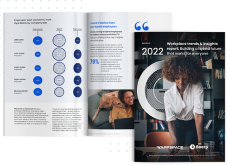
An employee experience strategy that wins
Larraine Solomon
September 28, 2020Employee experience strategies are effective when it comes to motivating and retaining employees, ultimately contributing to your business success.
In a competitive global job market, talented employees are looking for more than a job with perks, and offices with ping-pong tables and free massages are no longer in vogue. Instead, employees want to do meaningful work, to feel that they have supportive management and to have a positive work environment. Not to mention access to technology in order to make it easy to be productive and achieve their goals. People want to work in an environment where all elements of their work – the physical, intellectual, emotional and virtual are orchestrated to inspire. They’re looking for a good everyday employee experience.

At the same time, organizations realize that in a challenging economic environment, a thriving, highly productive workforce drives customer satisfaction and sustainable business success. This is directly impacted by the employee experience, and the way employees feel about coming to work is likely to have an effect throughout every aspect of the organization.
In 2015, Airbnb broke new ground by creating one of the first high profile ‘Chief Employee Experience Officer’ roles. Their subsequent decision to replace their HR department with a team devoted to building an employee experience strategy was seen as revolutionary. In fact, their engagement scores showed the impact of the Airbnb culture, with 90% of Airbnb employees recommending Airbnb as a great place to work.
Over recent years, a positive employee experience has become the expected contract between employers and employees. Marketing and product teams have moved beyond customer satisfaction and towards a total customer experience, while internal comms teams and HR continue to focus on building strategies and plans that continuously improve the entire employee experience.
Adding a digital lens to create an integrated employee experience
2020 has fast-tracked the need to improve the employee experience further for many workers who have moved into unchartered territory by indefinitely working from home.
With the prospect of remote working on the horizon for months ahead and with Zoom fatigue fast setting in, employees are clamoring for consumer grade workplace experiences that also help them feel connected to their colleagues, leaders and the organization.
As a result, organizations are developing an integrated focus on the entire employee experience––bringing together all the tools, technologies, HR, and practices that impact people at work. A growing array of communication and HR tools, alongside integrated employee self-service platforms, and even wellness and fitness apps are creating a workplace designed to tackle a new employee landscape. Intelligent Digital Workplaces are leading the way in this field.
7 tips to create an integrated employee experience strategy
As organizations across the globe continue to undergo unprecedented change, here are 7 tips to creating an experience strategy that will ensure that your employees stay with you and are able to do their best work.
1. Prioritize creating memorable experience points at critical stages of the employee lifecycle
Onboarding, promotion, job changes and retirement are among the most exciting and sometimes most challenging points in a career. Communicating, listening and responding to workers as they may be going through significant change is especially important.
2. Over-communicate your organization’s purpose, vision and mission
Many employees say that they would be more productive if they had a clearer sense of the purpose and direction of their company. People want to know why a company exists, what it will look like in the future, and the role that they can play in driving success. Aligning employees around a shared vision is made easier with good technology, connecting employees around important strategic topics no matter where they are located.
3. Enable managers to develop improved relationships with their teams
Line managers play a critical role in the way people feel about coming to work everyday. ‘People don’t quit a job’, the saying goes — ‘they quit a boss’. Employees want managers who are leaders – who communicate well, inspire and coach. Providing managers with the tools and technology that enables them to connect global employees to share ideas and best practice will have a significant impact on the overall employee experience.
4. Create a sustainable work from home digital ‘culture’
Today’s modern workforce is more mobile, collaborative, dynamic, and multi-generational than ever before. With employees working from home, digital workplace tools enable employees to collaborate and communicate as if they were working in an office. Improving the digital employee experience fosters efficiency, innovation and engagement for everyone across your organization.
5. Reduce information overload so that people can achieve their goals
There’s nothing more frustrating feeling overloaded with information from multiple sources simply to find what you need to get the job done. A poorly thought through communication strategy can lead to a complicated communication channel approach, creating confusion, noise and redundant messages.
Good digital technology can help ensure the right content finds the right employee at the right time. Not everyone needs the same information. Instead, employees should receive personalized communication, based on their location, department, language, interests and preferences.
6. Empower people through collaboration
Bringing people together from different backgrounds and different locations to work towards a common goal helps to solve customer problems and reduces ‘siloed working’. In the current environment, with limited access to physical offices, it is even more critical for employees to have access to the tools that will enable their voice to be heard. As the saying goes, ‘teamwork makes the dreamwork’.
7. Encourage visible leadership
Leaders have a profound impact on employees. The way they communicate, behave and the decisions they make has a significant impact on employee retention, motivation and productivity.
2020 has shone an even brighter spotlight on the need for company executives to communicate clearly and with authenticity. Employees have appreciated seeing and hearing from leaders, who, in many cases, have taken greater ownership of both content and the delivery of their messages. They have appeared on video, in Town Halls and in personal blogs, encouraging honesty and two-way interaction. As businesses face unprecedented opportunities and challenges in the months ahead, employees increasingly want mechanisms to both hear from leaders, as well as being able to contribute their feedback and ideas.
Powering an Integrated Employee Experience with a Digital Workplace
With remote working looking set to be the ‘new norm’ for many people, bringing together the tools, places, collaboration, culture and skills that employees need to do their best work is fostering empowerment, driving productivity and helping to serve customers more effectively.
From the shop floor to the top floor, Intelligent Digital Workplaces are reshaping the way that organizations build a compelling experience for all employees. In a unique way, they can integrate all of the technologies that employees use onto a single portal, from e-mail to instant messaging, enterprise collaboration, crowdsourcing applications, sales tools, HR applications and virtual meeting tools.
Employees no longer struggle with multiple passwords and screens – now, everything they need to do their job is accessible in one place. Borrowing all the rich features of common social media tools such as liking, commenting, tagging and sharing, digital workplaces make it easy for people to connect in a business setting, cutting across traditional silos and geographies.
Beezy’s Intelligent Digital Workplace
With the accelerating pace of technological change, the Beezy Intelligent Digital Workplace continues to push boundaries to continuously deliver forward-thinking improvements based on customer feedback and a changing world order. Powered by the Internet of Things (IoT) and Artificial Intelligence, this technology increasingly makes use of individual employee data, information and connections to create a personalized employee experience.
The New Beezy will be showcasing several bleeding-edge product enhancements based on the changing business environment. This includes solving the need to have a global and local intranet at the same time; improving the ability to connect employees to their most relevant content in a visually compelling way; bringing video content to life more effectively and the exclusive launch of a ground-breaking Microsoft Teams app to bridge the gap between Intranets and Team collaboration.
As we enter a new era of challenge and opportunity for global organizations, creating a positive employee experience has never been so important. Engaged employees who stay with you and are prepared to go the extra mile for customers and colleagues, will always underpin sustainable, profitable business results.



